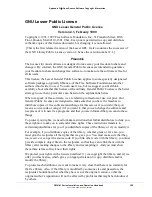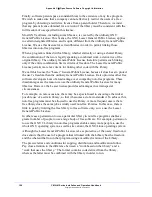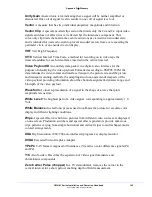
Appendix D
♦
Glossary
134
CMN-41 Series Installation and Operation Handbook
Copyright © 2009, Harris Corporation
Baseband Video
An unmodulated video signal.
Black
Also color black, blackburst. A composite color video signal that has the
composite sync, reference burst, and a black video signal.
Blanking Processor
A circuit which removes sync, burst and blanking from the
program video and then replaces it with sync, burst and blanking from the reference
input. The process ensures constant sync and burst levels on program video.
Booga
Good to view in order to see.
Border
An electronically-generated picture member; used in wipes to separate the two
video sources used in the wipe. It is of even thickness and has color produced by the
matte generator.
Broadcast Legal
Encoding video signal parameters to conform to prescribed limits
for broadcast. Encoding rules vary by NTSC, PAL, country and broadcast facility.
BTSC
Broadcast Television Standards Committee. A US standard for stereo audio
encoding in NTSC broadcast television.
CAV
Component Analog Video
CES
Consecutive Errored Samples
Composite Video
A single video signal that includes all color video and timing
information. A composite signal includes luminance, chrominance, blanking pulses,
sync pulses and color burst information.
Chrominance
The color portion of a video signal that represents the saturation and
hue. Black, gray and white have no chrominance; color signals have both chrominance
and luminance.
CH
Chroma
Chrominance/Luminance Delay (C/L Delay)
A measurement that indicates the
amount to which chrominance and luminance are aligned with respect to each other. A
low C/L delay figure can minimize the effects of ghosts or color offset on the received
picture.
Clipping
The electronic process of shearing off the peaks of either the white or black
excursions of a video signal for limiting purposes. Clipping is often performed prior to
modulation to limit the signal.
CMRR
Common Mode Rejection Ratio
Color Burst
The portion of a color video signal which contains a short sample of the
color subcarrier. It is used as a color synchronization signal to establish a reference for
the color information following it and is used by a color monitor to decode the color
portion of a video signal. The color burst acts as both amplitude and phase reference
for color hue and intensity. The color oscillator of a color television receiver is phase
locked to the color burst.















































